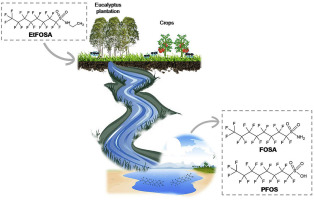Environmental Pollution ( IF 7.6 ) Pub Date : 2018-08-01 , DOI: 10.1016/j.envpol.2018.07.122 Rodrigo A. Nascimento , Deborah B.O. Nunoo , Ekhine Bizkarguenaga , Lara Schultes , Itsaso Zabaleta , Jonathan P. Benskin , Saulo Spanó , Juliana Leonel

|
N-Ethyl perfluorooctane sulfonamide (EtFOSA) is a perfluorooctane sulfonate (PFOS) precursor and the active ingredient in sulfluramid, a pesticide which is used extensively in Brazil for management of leaf cutting ants. Here we investigate the occurrence of EtFOSA, PFOS, and other per- and polyfluoroalkyl substances (PFASs) in soil, eucalyptus leaves, water (ground, riverine, and coastal (estuarine/marine)) and coastal sediment from an agricultural region of Bahia State, Brazil. This area contains a larger number of eucalyptus plantations where sulfluramid is suspected to be applied. Soil, leaves, and coastal water (marine/estuarine) contained ∑PFAS concentrations of up to 5400 pg g−1, 979 pg g−1, and 1020 pg L−1, respectively, with PFAS profiles generally dominated by PFOS and perfluorooctane sulfonamide (FOSA). Coastal sediment contained ∑PFAS concentrations of up to 198 pg g−1, with PFOS, FOSA, and perfluorooctanoic acid (PFOA) being the most frequently observed PFASs. These substances are all potential EtFOSA transformation products, pointing to sulfluramid as a possible source. In riverine water, ∑PFAS concentrations of up to 8930 pg L−1 were observed. PFOS and PFOA were detected in all river water samples. Groundwater also exhibited PFAS contamination (5730 pg L−1 ∑PFASs), likely from sulfluramid use. The observation of other PFASs (e.g. perfluorobutanoic acid) in freshwater suggests that other PFAS sources (in addition to sulfluramid) may be important in this region. Overall, these data support the hypothesis that sulfluramid use contributes to the occurrence of PFASs in the Brazilian environment.
中文翻译:

巴西农业中的磺胺嘧啶用途:环境中的全氟烷基物质和多氟烷基物质(PFAS)的来源
N-乙基全氟辛烷磺酸酰胺(EtFOSA)是全氟辛烷磺酸盐(PFOS)的前体,是杀虫草胺(一种在巴西广泛用于管理切叶蚂蚁的农药)中的活性成分。在这里,我们调查了巴伊亚州农业地区的土壤,桉树叶,水(地面,河流和沿海(河口/海洋))和沿海沉积物中EtFOSA,PFOS以及其他全氟和多氟烷基物质(PFAS)的发生, 巴西。该地区有大量的桉树人工林,怀疑使用了硫柳胺。土壤,叶,和沿海水(海洋/河口)含有至多的ΣPFAS浓度5400皮克克-1,979皮克克-1,和1020皮克大号-1分别具有通常由PFOS和全氟辛烷磺酰胺(FOSA)主导的PFAS分布图。沿海沉积物中的∑PFAS浓度高达198 pg g -1,其中最常见的PFAS是PFOS,FOSA和全氟辛酸(PFOA)。这些物质都是潜在的EtFOSA转化产物,指出磺胺草胺是可能的来源。在河水中,观察到的∑PFAS浓度高达8930 pg L -1。在所有河水样品中都检测到了全氟辛烷磺酸和全氟辛烷磺酸。地下水也表现出PFAS污染(5730 pg L -1∑PFASs),可能来自使用磺胺草胺。在淡水中观察到其他全氟辛烷磺酸(例如全氟丁酸)表明,在该地区其他全氟辛烷磺酸来源(除氟虫胺外)可能也很重要。总体而言,这些数据支持以下假设:在巴西环境中使用氟虫酰胺有助于PFAS的发生。








































 京公网安备 11010802027423号
京公网安备 11010802027423号